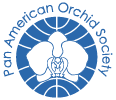This is a recovered text only newsletter originally hosted on the old Pan American Orchid Society website. Pictures were unable to be restored.
Pan American Orchid Society
Affiliated with the American Orchid Society
|
When Where |
Tuesday, September 16, 2008, at 7:30 p.m. Christ 11295 |
Dear
members and friends,
You will be receiving this newsletter
early this month as I will be out of town for the meeting.� Hopefully you will not suffer any damage to
your plants from the storm force winds.�
Essentially this newsletter is the same as last month.�
There will be
no Speaker this month.� Instead we
will be holding our popular bingo event.�
This means that there will be no raffle table and we will be winning the
plants from our bingo cards.
Refreshments
for this month:�� The following members offered to provide refreshments
for our meeting this month:� Thank you all for your contributions.
Pat Chen Yin
Brenda Martinez
Millie Ridley
Joan Manley
Eva Pikarsky
Maria Valls
Club News
At the Board Meeting last
week, it was agreed that there would be no deduction for the missed meeting in
August.
We are reinstituting the mini-class to be held at the beginning
of our monthly meeting.� This time it is
being taught by Mirta Russis
Heineman.� If
you want to take advantage of Mirta�s vast knowledge
and experience of growing all types of orchids, make sure you arrive at the
Church by 7
p.m.
Culture Notes – September (from AOS Monthly Checklist):
Cattleyas
Despite the shortening days and lowering angle of the sun,
September can still be one of the hottest months. �Water and fertilizer need to be in balance
with heat and light. �The alert grower
will notice, however, that his or her plants are beginning to slow down a bit.
Growths are maturing, and the sheaths are giving the promise of the next six
months’ bloom.
Check plants for potting needs for the last time this
season. �Any in dire need should be
potted, even some that may be on the cusp, as there is just enough of the
growing season left to allow the plants to establish before the days start to
get really short and cold.
Cymbidiums
Through diligent modern breeding programs, the cymbidium
season gets stretched longer and longer. �Now we can expect to have flowers open as
early as September and October. �Stake
inflorescences and move the plants to a shadier location to help the flowers
develop successfully. �Because the plants
will have warmth tolerance “built in” genetically, keeping the plants
as cool as possible will help prevent bud curl. �For the midseason varieties, inflorescences
should be initiated by now. �Feed plants
on a regular schedule with a balanced fertilizer (20-20-20) and shade the
plants lightly.
Dendrobiums
This is a good season for hybrids of the Dendrobium phalaenopsis and Dendrobium canaliculatum types.
Both are capable of putting on tremendous shows of long-lasting flowers. �Fertilize with a low-nitrogen formula to
promote the best flowers. �Dendrobium phalaenopsis can get
tall and top heavy, suggesting an attractive and heavy container would be
appropriate for this type.
Phalaenopsis
The bulk of this season’s growth is being ripened this
month, with growers in cooler climates seeing the first emerging
inflorescences. Some night heating may be necessary in the cooler areas. �Begin to watch watering more carefully, and
reduce feeding proportionately with reduced watering needs. �An extra dose of phosphorus and potassium,
such as a bloom-booster or high-acid-type fertilizer, is beneficial.
Tasks for September (from Martin Motes�
newsletter):
1.� Space plants to permit
more air circulation
2.� Trim trees to permit
more light and lessen the wind load on them
3.� Clean up growing area
removing any dead leaves or other organic matter
4.� Tidy up old pots or
other objects on the ground
5.� Apply snail bait;
lightly, frequently
6.� Spray quaternary
ammonium chloride (Physan, Consan,
Greenshield, Triathalon or
pool algicide)
See you all on
September 16,
2008 at 7:00 p.m.
